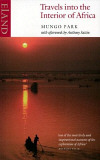Travels into the Interior of Africa
Date of first publication: 1799
Eland publication date: October 30, 2003
‘Soon after my return from the East Indies, in 1793, having learned that the noblemen and gentlemen, associated for the purpose of prosecuting Discoveries in the Interior of Africa, were desirous of engaging a person to explore that continent by the way of the Gambia River, I took occasion, through means of the President of the Royal Society, to whom I had the honour to be known, of offering myself for that service…’
Thus, begins one of the most compelling travel books ever written. Mungo Park (1771-1806?) was the first European to visit the Niger River basin in 1796 and managed to resolve, once and for all, a debate that had European cartographers and geographers confused for centuries as to which way the river flowed.
His initial journey (1795-1797) was a tale of tremendous personal hardship and suffering, but triumphant in the end. In 1805, he convinced the British government, in the middle of a war against Napoleon, to send another expedition to seek out the mouth of the Niger. With 100 officers and men he set out, retracing his earlier steps. It is details of these two journeys that make up the main narrative of this culturally important book. However impressive this journal of discovery seems today, it is the amount of deprivation and hardship that Park stoically endures that impresses most. Kidnap, starvation, wild animals, constant harassment by the natives, fever and linguistic problems seem to dog Park, but he continually shrugs these off and whilst wars and wild animals rage around him, he can be found out collecting information on flora and fauna, learning how to pan for gold or bartering in the local market for provisions or slaves. His understated prose and genially stiff-upper-lip belie the hardships which separate Park from other travel writers.
Park’s work is often derided as being focused mainly on the steps necessary for the development of trade links between the UK and Africa, but this is a gross over-simplification and he has produced here a detailed and complex study of African life. For example, on the native language: ‘their language abounds much in gutturals, and is not so harmoniou…’; on the natives of the Gambia: ‘The men are commonly above the middle size, well-shaped, strong, and capable of enduring great labour. The women are good-natured, sprightly, and agreeable…’ Clearly this is the work of someone who was deeply in love with Africa and actively tried to understand all its complexities.
Park provides many interesting details and asides, including the practise of Mumbo Jumbo for disciplining wayward wives. Throughout, the account attempts some degree of neutrality while noting acts of kindness and avarice by various individuals and rulers; although, not surprisingly, he explicitly criticizes the Moors, who continually interfered with his progress and those who robbed and stripped him. Perhaps his most disturbing account is of the female slave who becomes too sick to continue travelling with the coffle. Surprisingly enough, the entire work puts black slaves and their families in a very sympathetic light and shows the slave trade at its worst; although, due to the continuing conditions of slavery and internal conquest pre-dating major European involvement in the trade, Park stated that the termination of the Trans-Atlantic slave trade would not provide as great a benefit to the populace in Africa as many hoped.
The description of Park’s second, and largely ill-fated second journey is, undoubtedly, one of the most impressive and shocking pieces of travel writing ever written and is correctly considered as both classic travel writing and an important historical document in its own right. It is unlikely you will ever read anything, outside the pages of pulp fiction, so enthralling and so profoundly moving.
Travels into the Interior of Africa is a stunning book. As a piece of travel writing it is unlikely to be surpassed and as a glimpse of a strange land long since forgotten, it remains one of the definite works. It sets the standard against which all other travel writing should be judged.
——–
